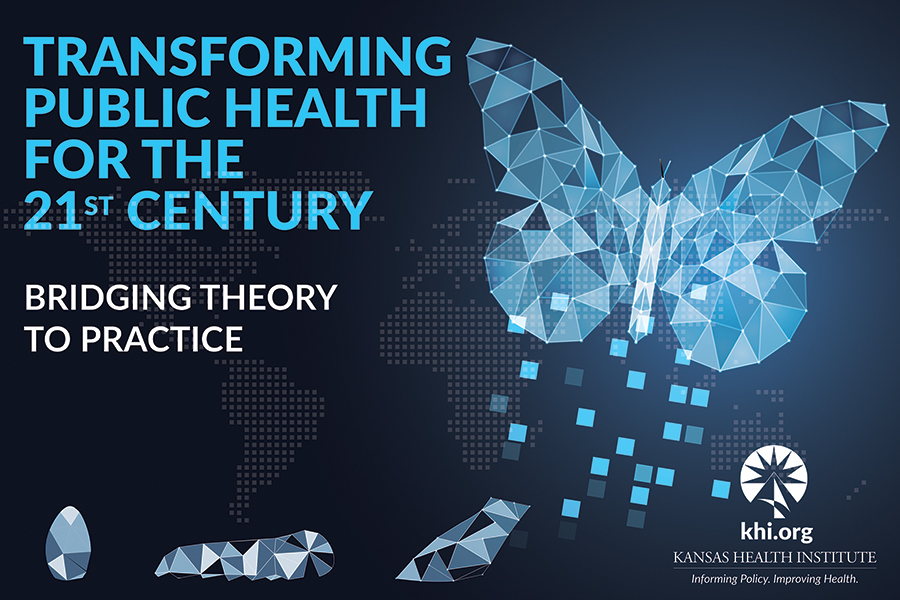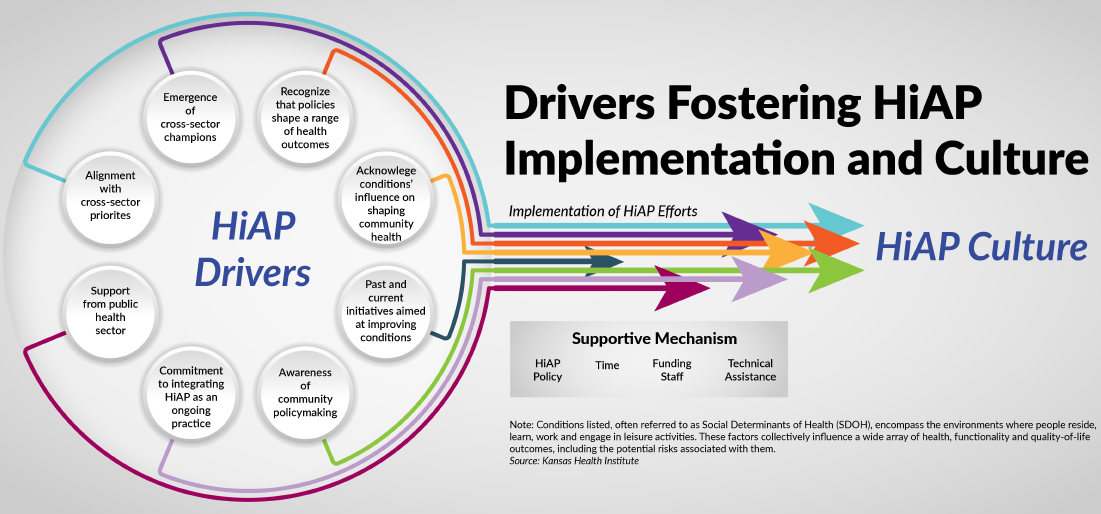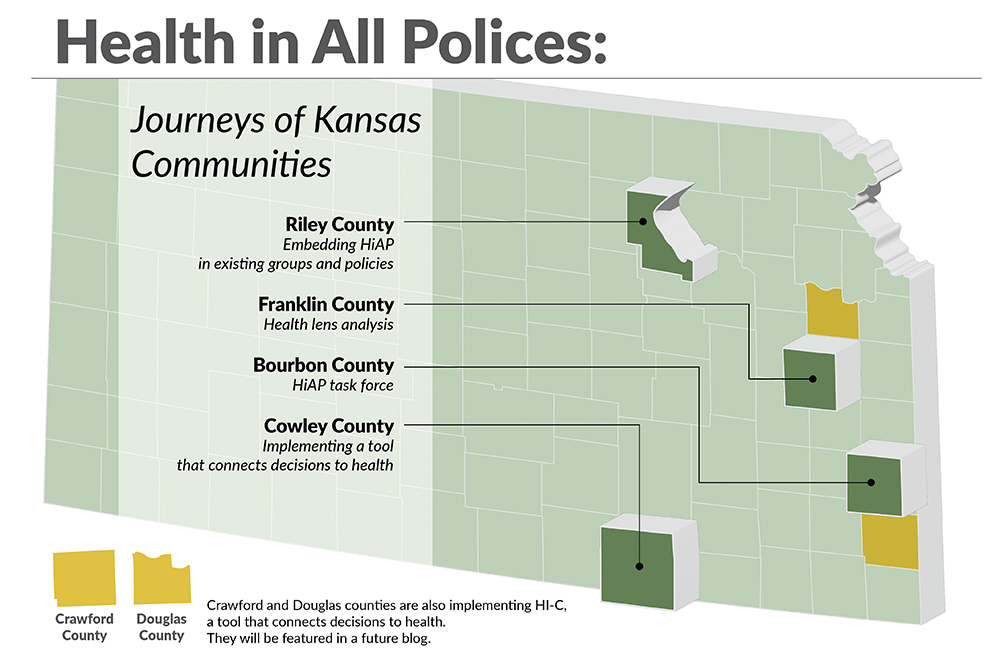A Spotlight on Bourbon County: HiAP Task Force
In Bourbon County, HiAP efforts were focused on creating the Bourbon County HiAP Task Force and were jump-started by the Healthy Bourbon County Action Team, Inc (HBCAT), which saw the strong value of intertwining HiAP concepts with economic development efforts. According to Jody Love, president and CEO of HBCAT, “At the Healthy Bourbon County Action Team, we are committed to building collaboration and community trust. The health policy task force is a way to enhance multi-agency communication, engage community members and coordinate efforts around a common vision.”
One initial challenge encountered when proposing the HiAP policy was navigating the political landscape. Initially, not all county commissioners were on board, prompting HBCAT to change their approach and pursue a memorandum of understanding (MOU) between other incorporated towns and the school district. Subsequently, as HBCAT continued to build buy-in among countywide stakeholders, it successfully secured the county commissioners’ signatures on the policy.
The Task Force operates under the MOU executed between the City of Bronson, City of Fort Scott, USD 234 and HBCAT. One of the goals of the group is to enhance access to previously unavailable opportunities and resources, specifically aiming to improve overall health outcomes and address health disparities in Bourbon County. To support these efforts, the Task Force, in collaboration with its members, will apply for grant opportunities that benefit various communities in Bourbon County. The Task Force also will work to provide recommendations on the health impacts of decisions to city and county commissions; identify local policies or codes that may hinder a healthy environment; foster communication and collaboration among governmental entities, businesses and community members; assist organizations in using data from community health assessments and improvement plans for informed decision-making; and seek joint funding opportunities to support health improvement initiatives.
A Spotlight on Cowley County: Implementing a Tool That Connects Decisions to Health
The City-Cowley County Health Department (CCCHD) centered their HAIP efforts on ensuring that the potential effects on community health and well-being are considered when community-wide decisions are being made. An opportunity to explore and implement this concept emerged as one of the cities in the county began to contemplate a new housing development. At a city commission meeting, CCCHD recommended conducting a health impact assessment before finalizing the decision. Consequently, CCCHD utilized the Health Impact Checklist, developed by the Kansas Health Institute, to evaluate the health impacts of the proposed Sleeth Addition Housing Project in Arkansas City. The team evaluated the development’s impact on housing stability and environmental conditions in the area, and considered development features, such as a proposed splash pad and the lack of a storm shelter. The findings and ways to maximize positive health impacts and address negative health impacts were shared with the city commission for consideration and any necessary action. Although CCCHD originally intended to spend more time building HiAP capacity before completing its first HI-C, it decided to dive right in to provide valuable information to decision-makers. Working and learning simultaneously wasn’t ideal, but ultimately, it led to a far greater appreciation for the depth and scope of HiAP.
Moving forward, CCCHD is committed to continuously informing decision-making by providing this type of assessment and information. To gather community suggestions on which decisions to assess, it created an HiAP page on its website. CCCHD also is establishing internal processes and protocols to stay informed about various community decisions and provide evidence-based information for future decision-making.
For Cowley County, one critical piece of building a foundation for HiAP was conducting a robust community engagement event it called the “Data Walk” in collaboration with RISE Cowley County. This approach helped the community connect the dots between a broad range of environmental, economic, educational and social conditions and health, identifying areas for improvement. Echoing the significance of these efforts, Tom Langer, administrator of the public health office at CCCHD noted, “To fully understand and address community-wide health conditions affecting children in Cowley County, a purposeful examination of health indicators was conducted through a Data Walk. Participants questioned what could be done to address the systemic issues identified. Adopting HiAP across multiple sectors, such as local government, education and private industry, was seen as the best approach for focusing efforts on providing long-term solutions.” Data and analysis for the Data Walk were provided by KHI. Since Cowley County, KHI has supported data analysis for three more Data Walks across Kansas.
A Spotlight on Franklin County: Health Lens Analysis
The Ottawa Recreation Commission, with support from Live Healthy Franklin County, took the lead in implementing HiAP. The commission was undergoing a strategic planning process for the years 2024‒2028, carried out by PROS Consulting and commission staff with input from the community. It commissioned a Health Lens Analysis to ensure that the strategic plan thoroughly incorporates health and equity considerations and strategies for maximizing services for all community members — particularly those facing barriers to health. According to Levi Meyer, executive director of the Ottawa Recreation Commission, “We made the decision to embark on Health in All Policies to ensure our strategic planning process was equitable toward the needs of our entire community. Our goal is to serve the community as a whole, and the HiAP process helped ensure we were taking into consideration the needs and interests of all individuals within our community.” The analysis was conducted by KHI, with support from the Live Healthy Franklin County Coalition and a faculty member from Baker University.
The analysis led to over 50 recommendations for the Strategic Plan, all aimed at enhancing the community’s engagement and inclusivity within programs, services and policies. PROS Consulting integrated recommendations from the analysis throughout the Plan. Among these recommendations were strategies including the integration of community engagement elements into future commission decisions regarding services, programs and policies; equipping staff with the necessary skills to work effectively across diverse cultures, backgrounds and languages; ensuring services are designed to meet the varied needs of community members; and ensuring that marketing and communications about programs and services are accessible to all community members.
As a result of this process, the commission feels more adept at incorporating the Health Lens Analysis approach into its various operations and decision-making. Making Health Lens Analysis a standard part of regular procedures will ensure the consistent consideration of health and equity. Currently, the commission intends to use some of the insights gained as it explores the feasibility of developing an inclusive and accessible playground and acquiring a communication board designed to meet the linguistic and cultural needs of the diverse community members.
Baker University will host a guest lecture on Health in All Policies, delivered by KHI. It is considering integrating this topic into the class curriculum, which will strengthen local capacity and workforce skills.
A Spotlight on Riley County: Embedding HiAP in Existing Groups and Policies
Since its inception, Flint Hills Wellness Coalition has approached all of its work from an HiAP perspective, so it was natural for it to select this Pathways package. Initially, the coalition spearheaded the HiAP initiative by focusing on training individuals who are already well-connected within various groups to assist in embedding health and equity considerations into decision-making processes. These individuals engaged with various groups to build a foundation for HiAP efforts. Additionally, the coalition developed an HiAP policy for the Food and Farm Council of Riley County and the City of Manhattan, encouraging the council to adopt the HiAP approach in the development and implementation of all projects.
While the coalition continues to build buy-in among public entities for the adoption of formal policies, such as resolutions, it also continues to identify opportunities to insert HiAP into the conversation. The most recent example is the inclusion of HiAP in the proposed update of the Riley County Comprehensive Land Use Plan, both in the sections on housing and health. Furthermore, the coalition is convening a larger cross-sector community in Riley County to enhance its understanding of HiAP and will provide mini-grants to public entities or nonprofit organizations with the hope that the organizations will adopt resolutions or policies within the next several months.


